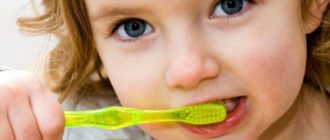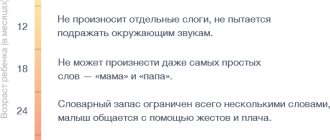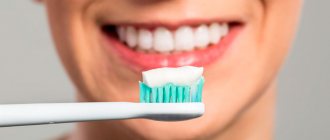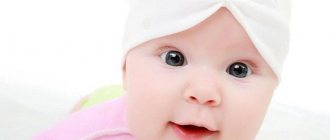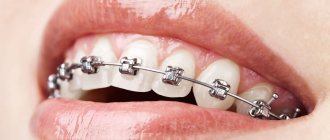How teeth are cut: the order in which they appear
Every adult can understand how a baby feels when his first teeth are cut - just remember how the so-called “wisdom teeth” appeared.
Swelling of the gums, itching and pain - you must admit, this is not pleasant. Therefore, infants often become capricious during the teething process. They may lose appetite and sleep, and even have a slight rise in temperature. The earliest time for baby teeth to erupt is at the incisors (front teeth). There are four of them on each jaw. As a rule, the lower two incisors erupt first (at 6-8 months), then the upper central incisors. The teeth appear in pairs opposite to each other, this is important for the formation of a correct primary bite. At 8-12 months, the baby develops lateral incisors (first on the lower jaw, then on the upper). At one year old, a child should have eight teeth. After this there is a short break in their appearance.
Next in the sequence are fangs. There are two of them on each jaw. The location and structure of these teeth makes their eruption especially difficult and difficult for the child. At the age of 16-20 months, fangs will appear on the lower jaw, and then on the upper jaw. Then comes the turn of the painters (large molars). They begin to erupt at 20-30 months, each child at its own time. There are a total of 20 teeth in the primary occlusion, 10 on each jaw: 4 incisors, 2 canines and 4 painters. All of them should appear by 2.5-3 years.
Symptoms of teething in a child
The appearance of primary teeth is a natural physiological process, however, a number of children develop a symptom complex, which, according to the International Classification of Diseases, is classified as teething syndrome (ICD code - K00.7). Numerous examinations of young children indicate that the most common symptoms accompanying the appearance of teeth are:
- increased salivation - processes in the oral cavity are activated;
- irritability - the child experiences severe discomfort and cannot communicate this in any other way than by changing behavior;
- sleep disturbance - the pain is so severe that the baby cannot sleep or often wakes up during the night;
- itching of the gums - children try to compensate for this by trying to bite the breast or pacifier, by trying to hold their hands, toys, clothes in their mouth.
Such precursors of the appearance of a tooth occur in 35-60% of children. But some infants may experience nonspecific symptoms [2]:
- cough;
- runny nose;
- rash;
- diarrhea;
- heat;
- refusal to eat.
On average, symptoms appear 5-8 days before the tooth appears. When several teeth erupt at the same time, this usually increases discomfort.
Even if the picture of the child’s illness is very similar to the symptoms of teething, consultation with a specialist is necessary. Be sure to consult a doctor if you experience diarrhea or fever for a long time.
Signs of teething
How can parents understand that their child is teething? The easiest way to find out about this is by the child’s changed behavior. He sleeps worse and is capricious. He loses his appetite (may completely refuse to eat). But similar symptoms can be caused by other reasons. Therefore, the most obvious sign can be considered swelling of the gums (a small red bump appears on it, which parents can feel rather than see).
The child's changed behavior is associated with the movement of the tooth in the jaw. It seems to tear the gums from the inside, which explains the unpleasant sensations: itching, burning and pain. To remove them, the child can scratch his gums, pull various objects into his mouth, and bite. You cannot stop this behavior; you just need to replace inappropriate objects (for example, toys) with special teethers, the purpose of which is to help relieve the unpleasant consequences of teething.
It is because of the unpleasant sensations that the child may begin to refuse food, especially hot food (increases the pain). A light massage of the gums may help, which should be performed before feeding. It will relieve some of the itching and pain.
During teething, the baby's temperature can rise to 38º, but not higher. Until the teeth appear, parents should pay as much attention to the child as possible, distracting him from unpleasant sensations. This will help the baby get through a difficult time for him.
How to help your child when teething
Teething in children, or more correctly, teething, is quite often accompanied by various changes in the behavior and well-being of the baby, which is very frightening for parents who are not prepared for such a development of events. What dental symptoms in children should alert adults to what to do?
Helping your baby while teething
If, when teething, the baby is simply worried, he is constantly salivating, he sucks his fingers or tries to scratch his gums with something, it is quite simple to help the baby:
- Get some very soft wipes and constantly wipe away any saliva. This will protect your baby from facial skin irritation. At bedtime, place a napkin under your baby's head to absorb any involuntary saliva.
- Be sure to buy high-quality special silicone toys for developing gums - teethers, or special rings with liquid so that the baby can chew on them. The liquid makes the rings softer and pleasantly cools the gums (the rings can be stored in the refrigerator). Don’t save money - take only branded, certified products. After all, this is the health of your beloved child.
- Periodically massage the gums using a special nozzle, or just with your finger (wash your hands thoroughly, keep your nails short, with neatly trimmed edges), maybe with a moistened gauze swab. This procedure will also prevent the occurrence of stomatitis (“Stomatitis in infants - types, causes, symptoms”).
- Putting your baby to your breast more often is a great way to soothe him and relieve itchy gums.
- Some kids enjoy sucking and gnawing on bagels, a crust of bread, an apple without the peel - suggest it, it’s a good distraction.
- It is strictly forbidden to lubricate the gums with various medications without a doctor’s prescription, or to give the baby pills and mixtures on your own. Only a specialist - a pediatrician or pediatric dentist - can prescribe an ointment or gel to relieve pain, and a preliminary test for allergic reactions must be carried out. Although ointments and gels with lidocaine (Kamistad, Kalgel) are sold without a prescription, you should not lubricate the baby’s gums without checking, because if the baby is allergic to lidocaine, the baby may experience anaphylactic shock. For allergy sufferers, the doctor prescribes a special ointment called Baby Doctor or others.
- Try to distract your child, spend more time playing with him, and going for walks.
When should you see a doctor?
You should definitely consult a pediatrician if the following signs of teething are observed in your child:
- heat;
- vomit;
- diarrhea;
- runny nose;
- cough;
- skin rashes;
- convulsions;
- constant drowsiness;
- prolonged irritability, moodiness.
In any case, such symptoms should be a reason to consult a doctor. Often parents, on the advice of grandmothers, attribute everything to the fact that the child is teething; fever, they say, happens to all children. But no. Most children tolerate tooth growth without fever. And elevated temperature is a sign of most diseases. Therefore, you can miss the onset of some disease or pathological process that coincides with the period of teething.
Why does the temperature appear? The fact is that at the site where the tooth erupts, the gums swell, which is associated with the raising of the tooth and an increased influx of biologically active substances. The body reacts to this with a protective increase in temperature - to prevent infection of the gum cut by sharp edges. Dental fever lasts for one to two days. If the child tolerates this easily, is not predisposed to convulsions, and the doctor does not find other reasons for the increase in temperature, then it is not necessary to bring it down to 38 degrees. In case of a longer increase in temperature, examination of the baby and consultation with a doctor are necessary.
should be wary of vomiting during teething, unless other causes of this condition are excluded. All changes in the gastrointestinal tract have a fairly simple explanation: during this period, a lot of saliva is produced and the child constantly swallows it frequently, which causes increased secretion of gastric juice and vomiting (rare), as well as increased intestinal motility, which means diarrhea in a child during teething. Diarrhea occurs rarely (2-3 times a day), the discharge is watery and lasts no longer than 2 days. If the diarrhea is more frequent, prolonged, streaked with blood, with an increase in temperature and refusal to eat, immediately seek help from a medical facility - it could be an intestinal infection that the baby contracted when scratching his gums. In this case, treatment in a hospital is indicated, since the patient’s condition can deteriorate very quickly due to dehydration.
The accumulation of saliva in the throat often causes a wet cough, and its flow into the nasal passages causes a runny, watery runny nose. These conditions do not require treatment and disappear without a trace in 2-3 days. But only a pediatrician can assess the causes and severity of these pathological processes. In order not to confuse real illnesses with complicated conditions during teething, or in any violation of the baby’s behavior or health, consult a doctor. It’s better to be safe a hundred times than to regret a missed opportunity once.
Replacing baby teeth with permanent teeth
Eruption of molars begins at the age of 6-7 years. First, the large molars are shown (usually on the lower jaw). Then the pattern of baby teeth eruption is repeated. The incisors on the lower jaw are the first to change, and at the age of 7-8 years, the incisors on the upper jaw are also replaced. At the same time, the lower lateral incisors can also change.
At 8-9 years old, the upper incisors will change. It's the fangs' turn. At the same time (9-10 years), teeth that were not in the primary occlusion - premolars - begin to grow. There are four premolars on each jaw - two on the left and two on the right. At the age of 12, the fangs on the upper jaw will change. At this stage, the formation of the height of the bite begins, which has both aesthetic and functional significance.
The last teeth (wisdom teeth or third molars) appear between the ages of 17 and 25. Only after this can we say that the formation of the dental arches is completely completed.
When replacing baby teeth with permanent molars, it is important to pay attention to the bite. It is easy to correct at a young age, while adults will have to correct it throughout their lives. By regularly visiting a pediatric dentist, you can intervene in the process of bite formation in a timely manner. In addition, a specialist can monitor the eruption of baby and molar teeth (so that it is not too early or late), give recommendations to alleviate the child’s condition, and recommend special baby suppositories or gels for teething.
Ways to relieve discomfort
To make teething easier for your baby, you need to:
- provide additional attention and care from parents;
- if the baby is breastfed, put him to the breast more often, as this has a slight sedative effect;
- purchase several silicone teethers that can be cooled and offered to the child throughout the day;
- massage the gums with a finger wrapped in a clean gauze swab or a special silicone nozzle;
- promptly blot away any saliva with a clean napkin to avoid irritation of the skin around the mouth;
- if necessary and in consultation with a doctor, use medications.
Today, there are pharmacological and non-pharmacological methods of therapy for the eruption of primary teeth.
Local preparations
As a symptomatic aid for severe discomfort associated with teething, the pediatrician prescribes gels and ointments.
Such gels and ointments for teething with proven effectiveness are divided into 3 groups [1]:
- Preparations with an anesthetic effect based on anesthetic (lidocaine, choline, benzocaine). Sometimes lidocaine-based drugs contain anti-inflammatory or antiseptic components, providing a combined effect of the gel.
- Medicines based on anti-inflammatory or antiseptic agents.
- Preparations based on medicinal plant extracts. They use extracts of Roman chamomile, boswellia, aloe, marshmallow, Indian ivy, rhubarb, calendula and other components of plant origin.
Homeopathic remedies for teething are also produced, but their effectiveness has not been scientifically proven [1].
Systemic drugs
In cases of severe pain and hyperthermia, non-steroidal anti-inflammatory drugs are used, which reduce body temperature and have a systemic analgesic effect. The dosage and drug suitable for the child should be selected by a pediatrician.
Distractions
These include: the gum massage described above and baby teethers, which help the child temporarily reduce itching in the gums.




